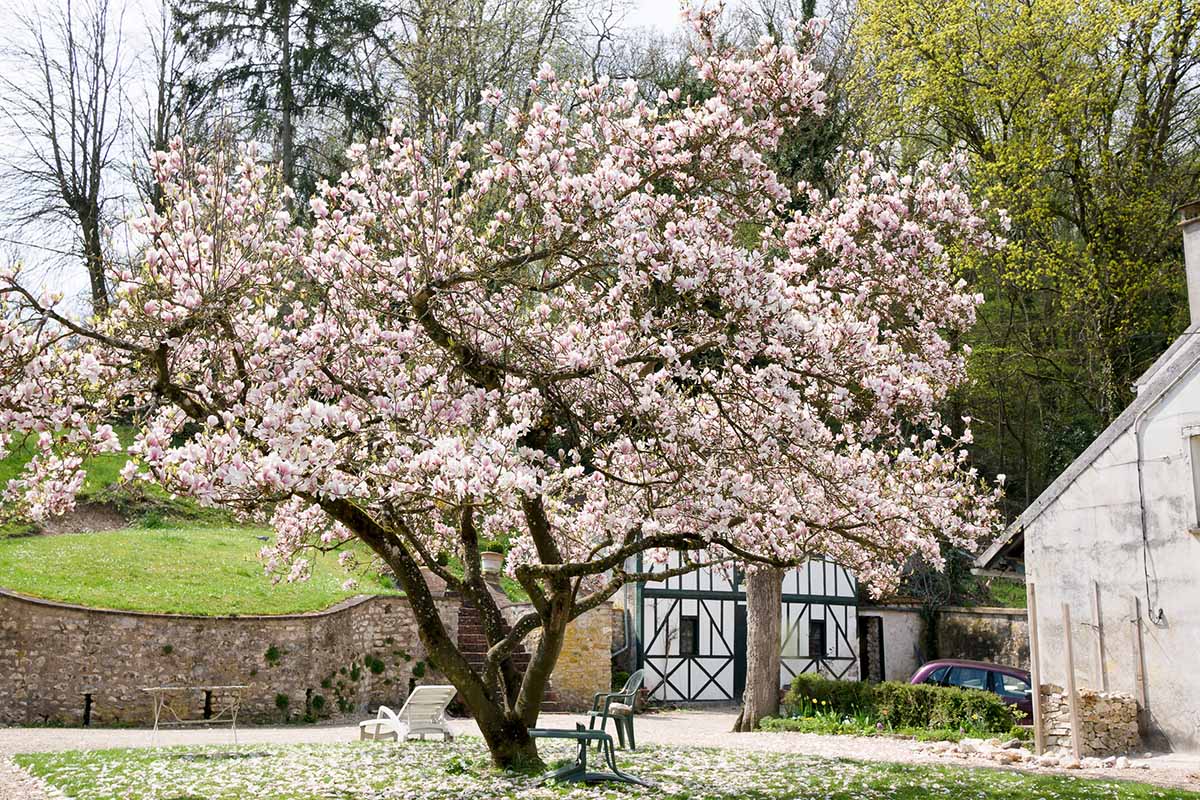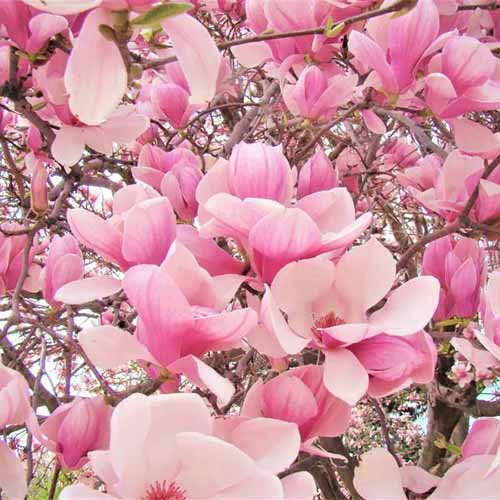
Magnolia x soulangeana
The most popular deciduous magnolia, Magnolia x soulangeana, produces heaps and heaps of large purple, pastel pink, and white blossoms on bare branches in the spring.
But it’s not a tree that occurs in nature. It’s a hybrid cross of two not-so-popular species. The result is one of the best magnolia options out there: the saucer magnolia.
What makes this hybrid so fantastic? It produces an almost unreal number of blossoms. The tree is so densely robed in elegant flowers that you can’t even see the branches underneath.
It maintains a petite size compared to other species in the genus, averaging around 20 feet tall, and it’s relatively untroubled by diseases and pests.

We link to vendors to help you find relevant products. If you buy from one of our links, we may earn a commission.
Need a focal point in the garden but lack space? Want something that will produce a brilliant show without much work on your part? Looking for a tree that isn’t going to need constant pampering?
The answer to all three of those questions is a saucer magnolia.
In our guide to growing magnolias, we discuss how to cultivate these trees in your landscape. In this guide, we’ll zero-in on the saucer magnolia, and how to make this tree thrive.
Here’s what I’ll cover:
It always helps to understand a bit about a tree’s history before you jump into growing it. That way, you can have a good idea of what the plant needs. Let’s go over that first.
Cultivation and History
Saucer magnolias (Magnolia x soulangeana) don’t appear naturally in the wild.
They’re cultivated hybrid crosses of two magnolia species: lilytree (M. denudata) and tulip magnolia (M. liliiflora).
The Yulan, Chinese, or lilytree (M. denudata syn. M. heptapeta) magnolia is native to central and eastern China and has been cultivated for hundreds of years, with records of specimens planted in Buddhist temples dating back to 600 AD. It arrived in England in 1780.

M. denudata trees grow up to 30 feet tall and produce lots of citrus-scented, thick-petaled white flowers.
The Mulan, purple, red, lily, or tulip magnolia (M. liliiflora) hails from southwest China and has been popular in Japan for centuries, though it’s not native there. It was introduced to Britain in 1861 from Japan.

It’s smaller than many other species, at just 12 feet tall or so. The flowers are pinkish-purple.
Saucer magnolias combine the best features of both species.
They are small in stature at about 20 feet tall and 15 feet wide at maturity. In the early spring in Zones 5 to 9, large white, pink, and maroon flowers bud out on the stems and open up with a cupped or globular shape, measuring up to 14 inches in diameter.
The flower color, size, and shape varies depending on the cultivar. The one feature they all have in common is that the trees are extremely floriferous. When they’re in bloom, you can hardly even see the branches underneath.

After the flowers fade, they are followed by alternate, elongated leaves. Underneath all that is smooth, gray bark.
When they’re young, the trees tend to grow in quite an upright habit, but they take on a rounded or oval shape as they age.
We have French botanist and biologist Etienne Soulange-Bodin to thank for this flowering wonder. He tinkered around with the parent species and eventually bred and named the saucer magnolia in 1826.
He was impressed with its prolific flowering, and it quickly became popular in France, England, and North America. Now, there are dozens of cultivars available and you can find this tree growing in landscapes and parks practically everywhere that has the right climate.
Saucer Magnolia Propagation
As a hybrid, it’s best not to try to propagate saucer magnolia from seed as it won’t grow true and your patience is unlikely to be rewarded.

Buying a plant from a nursery for transplanting or propagating via stem cuttings are both reliable ways to get started.
From Cuttings
Propagating stem cuttings creates an exact clone of the parent plant, so if you love a particular tree, you can take a few softwood cuttings and recreate it.
In the spring just after the leaves open, find a branch that is soft and pliable with new growth and healthy foliage. Cut about eight inches in length with the end at a 45-degree angle.
Remove all the leaves except the top two. If both leaves are relatively large when compared to other foliage on the tree, cut them in half vertically. Too much foliage will drain the limited resources in the cutting before it can develop the roots.
Fill a gallon-sized container with a seed-starting mixture. Dip the end of the cutting in rooting hormone and insert it into the center of the container about two inches deep.
Moisten the medium well and place the container in an area with bright, indirect light. If you live in a dry climate, it can help to tent some clear plastic over the cutting to retain humidity. Don’t let the plastic touch the stem cutting, though. Prop it up with a chopstick or other type of support if necessary.
Keep the soil moist and wait for the cutting to develop new growth. When new growth is apparent, you can transplant the rooted cutting into the garden in the spring or summer.
Transplanting
Purchasing a saucer magnolia from your local nursery or garden center isn’t as cheap as growing from cuttings, but you get a headstart, and it’s certainly much easier.
Plan to buy and transplant your young tree in the spring. Many trees do best when you plant them in the fall, but magnolias prefer to be transplanted in the spring.
When you bring home your potted tree, dig a hole that’s the same depth and twice as wide as the container the tree is currently growing in.
Remove the plant from the container and gently loosen up the roots. You want them to grow out and away from the center, not circle around, which might happen if the plant has been growing in the container for a while.
Spreading the roots helps prevent girdling the tree, which is when the roots grow in a circle at or below soil level, and can eventually strangle the tree.
Set the plant in the ground at the same height as it was in the container and fill in around the roots with soil. Water well and add more soil, if necessary.
The more compact saucer magnolia cultivars such as ‘Brozzoni,’ ‘Lilliputian,’ and ‘Verbanica’ can be grown in containers.
Choose a large container, something ten gallons or bigger, that has several drainage holes. Make sure it’s got some weight to it so you don’t have to worry about your tree tipping over.
Fill the container with a standard potting mix. Anything that drains well and is water retentive will work.
I’m partial to FoxFarm Ocean Forest potting soil, which you can find in 12 quart bags available via Amazon.
Remove the plant from its growing container and loosen up the root. Set it in the new container and backfill with the potting soil.
You want the tree to be sitting about the same height it was in the growing container or maybe an inch or two higher. Water well and add more soil if it settles.
How to Grow Saucer Magnolias
Saucer magnolias grow well in full sun to part shade locations in Zones 5 to 9, though shade will reduce flowering.
Saucer magnolias are pretty tolerant of conditions that trouble other magnolia species, like wind and alkaline soil.
The branches don’t break as easily as some species and though they prefer organically-rich, well-draining, slightly acidic to neutral soil with a pH between 6.0 and 7.5, they’ll tolerate a pH up to 8.0.

These trees do best in areas with consistently moist soil. Any extremes on either end of the spectrum, whether that’s too dry or soggy and waterlogged, will stress or kill the tree.
That means you’ll need to irrigate if Mother Nature doesn’t provide the necessary moisture. Anytime the soil begins to dry out, add water until it feels like a well-wrung-out sponge.
It’s especially important to stay on top of watering for the first five years of the plant’s life. After that, it can tolerate a bit more variance.
Containers dry out faster than ground soil, so you’ll need to keep a close eye on the soil moisture, especially during dry spells.
Now, we have to talk about the heartbreaking part of growing this plant. After waiting patiently all winter long, in early spring the buds swell and the flowers open. Then along comes a late frost, and boom. The flowers are dead, and you have to miss out on this year’s display.

There isn’t much you can do to prevent this other than select one of the cultivars that bud out a bit later in the spring if your area is prone to late frosts. If you have enough frost cloth and you can reach the entire tree, you can cover it to protect the buds and blossoms.
Try to avoid planting next to a brick or cement wall that faces south. This area is usually warmer than the surrounding area and it might encourage the flowers to bud out earlier than normal, leaving them exposed to late frosts.
To encourage lots of blooms, feed the plant once in the spring each year after flowering with an all-purpose food.
I reach for Down to Earth’s All Purpose food because it comes in a compostable box and is made from good stuff like bone meal, feather meal, alfalfa meal, and kelp meal.
Down to Earth All Purpose Food
If you’d like to grab some, head to Arbico Organics.
They also carry a tree and shrub mix, which contains similar goodies with the addition of eleven strains of mycorrhizal fungi to support healthy roots.
Down to Earth Tree and Shrub Mix
It’s also available at Arbico Organics in five- or 15-pound boxes.
Growing Tips
- Grow in full to partial sun.
- Plant in loose, rich soil.
- Keep the soil consistently moist.
Pruning and Maintenance
Alright, strap in. We’re about to dive into the complex world of pruning magnolias. Wait, did I say complex? I meant to say incredibly simple.
You probably don’t ever need to prune your saucer magnolia, unless there’s a problem like a broken branch or signs of disease.

When the trees are young, you can prune them to encourage a more tree-like shape if that’s what you prefer, since they can sometimes take on a shrubby appearance.
Otherwise, prune off any diseased or damaged branches as you see them.
You don’t even need to prune to open up the canopy, as you do with some species, unless you want to. The best time to prune for shape is in the spring before the blossoms open.
If you are growing your specimen in a container, you shouldn’t need to repot, but if you start to see roots growing out of the drainage holes, remove the tree (enlist the help of a friend) and trim the roots and put the plant back in the pot.
Then, trim the canopy a bit to reduce the load on the roots.
Saucer Magnolia Cultivars to Select
There are a few popular cultivars that you can find at garden centers and nurseries, but many places just carry the ever-popular original.
And why not? It’s practically perfect; no improvement needed.
Pop on over to Nature Hills Nursery for a live plant in a #2 or #3 container.
Of course, there’s no reason not to enjoy one of the many marvelous cultivars as there are options with white flowers, more compact shapes, and even more floriferous blooming.
Alba Superba
With large, heavily fragrant flowers that are mostly white with just a hint of purple blush at the base, this cultivar is dressed in a pale robe of flowers for weeks in the early spring.
It grows to about 20 feet tall, making it ideal for smaller spots.

Bred in The Netherlands at the Van Geert Nursery in 1866, This cultivar gained a steady following and nabbed the Royal Horticultural Society’s Award of Garden Merit in 1969.
Alexandrina
‘Alexandrina’ maintains its 20- to 30-foot height with a compact growth habit without any effort on your part.
Just plant it and watch it grow and bloom with its purplish-pink and white cup-shaped, fragrant flowers.
It was discovered in France in 1831 and has since diversified based on where it is grown. Those in Europe tend have paler blooms, while North American clones are darker.
The only downside is that this cultivar blooms early, which means late frosts can kill the blossoms. Nature Hills Nursery has this versatile beauty in #1 and #5 containers.
Lennei
A small tree that only grows to about 15 feet tall, with relatively small flowers at just four inches in diameter, ‘Lennei’ still manages to make a big statement.

Each blossom is deep purple and rose on the exterior and creamy white inside. So the tree looks vibrant pinky-purple as the flowers bud out and then takes on a bicolored appearance as they open.
The blossoms appear a little later than other saucer magnolias, and they might pop up again in the summer in smaller numbers.
Managing Pests and Disease
Saucer magnolias are relatively free from pests and diseases. I will, however, suggest that you set up camp in the spring as the buds are developing.
Arm yourself with an air horn and a good book, and blast the squirrels out of the area, because they will eat the flower buds.
Deer ignore them, though, so that’s a relief!
There really aren’t many diseases to worry about and the only insect pest to stress about is scale.
Scale
Magnolia scale (Neolecanium cornuparvum) is the largest scale insect in the US, coming in at nearly half an inch in diameter.
It’s a North American native and it doesn’t feed on anything but magnolias, with saucer being one of its favorites.

The pests are orange-pink and oval with a white waxy coating, and they use their sucking mouthparts to draw the sap out of the trees.
Light infestations may stress the tree, causing leaf drop or branch dieback, but in the case of a heavy infestation, a tree can die.
As they feed, the insects excrete a sticky substance known as honeydew. Not only does this drop onto the lawn, cars, walkways and anything else under the tree, but it also attracts unsightly sooty mold.
Applying a dormant oil before the flowers open can help give you a head start on the season, but true control involves encouraging natural predators like ladybugs and green lacewings.
A healthy garden should have a good balance of pests and predators, so working towards diversity is important. In the short term, you can buy beneficial predators to release into your garden.
You can find green lacewings in a variety of quantities to help your native populations available at Arbico Organics.
It’s possible to use insecticides, but these will kill the good bugs along with the bad, so you end up fighting the problem year after year. It’s best to reserve pesticides for severe infestations that threaten the life of the tree.
Learn more about how to deal with scale insects in our guide.
Tulip-Poplar Weevils
Tulip-poplar weevils (Odontopus calceatus) will chew holes in the leaves, but they aren’t anything to worry about.
Just know that if your tree has some holey leaves, that’s likely the cause. If it drives you nuts, treat them with insecticidal soap.
Verticillium Wilt
In terms of disease, verticillium wilt is evil. It can rapidly kill an otherwise healthy, mature tree and there is no cure.
Look for symptoms like leaf scorch, unusually heavy seeding, and branch death. Because the symptoms are somewhat vague, cut off a branch and strip the bark. If you see brown streaks or brown sapwood, you can confirm the problem.
If your tree is infected, you can’t save it. Remove it to prevent infecting other plants.
The fungus lives in the soil for years, so don’t plant anything there that’s susceptible to the disease for at least ten years. And many, many trees are susceptible.
The list of those that aren’t susceptible is pretty short. Try growing birch, ginkgo, juniper, spruce, pine, dogwood, hawthorn, fig, mulberry, oak, sequoia, and willow trees instead.
Best Uses for Saucer Magnolias
The saucer magnolia can be grown in a large container if you’re willing to prune consistently. Talk about a focal point on your patio!

You can also use the tree in espalier, but please, please don’t train it against a wall. The heat will reflect off the wall and onto the tree and cause it to flower a bit earlier, leaving it exposed to killing frosts.
Otherwise, the saucer magnolia makes a perfect specimen or background tree in the landscape. The more compact cultivars can make a major impact in a small space.
If you opt to allow the tree to take on a shrubby appearance, you can plant a few as a floriferous hedge for privacy or to create a natural boundary.
Magnolia flowers are also edible, and I find the blooms from saucer magnolias to be some of the tastiest.
The deeper the color, the more floral and citrus the flavor seems to be. Pickle them, use them in tea, or chop them up to add a bit of color to salads.
Quick Reference Growing Guide
| Plant Type: | Deciduous flowering tree | Flower/Foliage Color: | White, pink, purple/green |
| Native to: | Cultivated hybrid | Maintenance: | Low |
| Hardiness (USDA Zones): | 5-9 | Tolerance | Alkaline soil, wind |
| Bloom Time: | Spring | Soil Type: | Loose, rich |
| Exposure: | Full to partial sun | Soil pH: | 6.0-7.5 |
| Time to Maturity: | 10 years | Soil Drainage: | Well-draining |
| Spacing: | 15 feet | Attracts: | Birds, beetles |
| Planting Depth: | Same depth as growing container | Companion Planting: | Barrenroot, deadnettle, ferns, hostas, ivy, sweet woodruff, vinca |
| Height: | Up to 30 feet | Uses: | Specimen, container, espalier, hedge, edible |
| Spread: | Up to 30 feet | Order: | Magnoliales |
| Growth Rate: | Moderate | Family: | Magnoliaceae |
| Water Needs: | Moderate | Genus: | Magnolia |
| Common Pests and Diseases: | Squirrels, scale, tulip-poplar weevil; verticillium wilt | Species: | x Soulangeana |
Sit Back and Enjoy the Show
It’s hard not to love a plant that lets you basically sit back and enjoy the show with little work on your part, but that’s the saucer magnolia for you.

And show me a spring-blooming tree that is as impressive. The blossoms are huge, colorful, and there are just so many of them. I think the fact that they bloom on bare branches before the leaves emerge makes the display even more impressive.
What plans do you have for your new saucer magnolia? Or do you already have one? What’s your favorite part about it? Let us know in the comments.
And to learn more about growing magnolias, have a read of these guides next:












